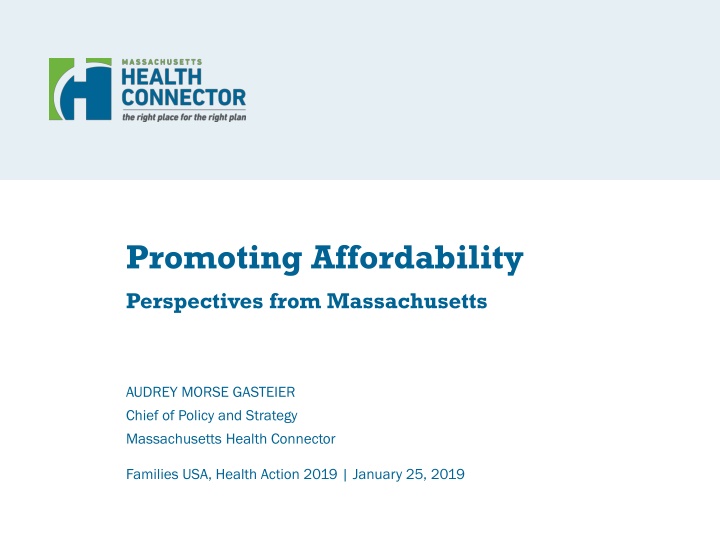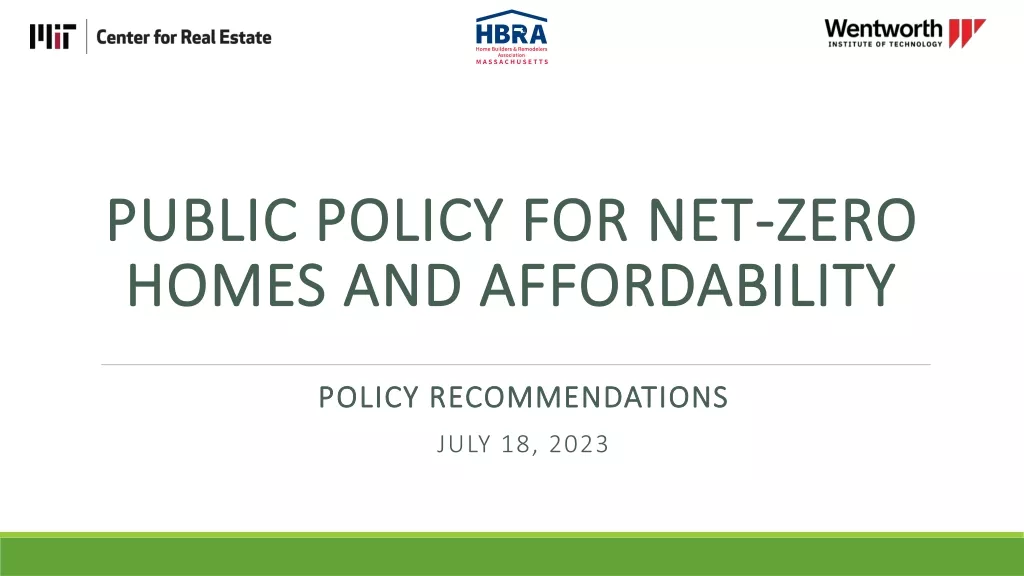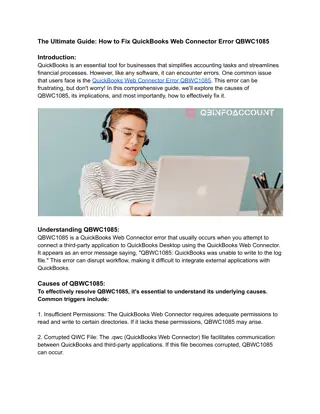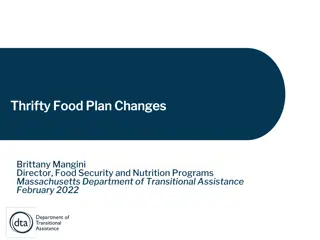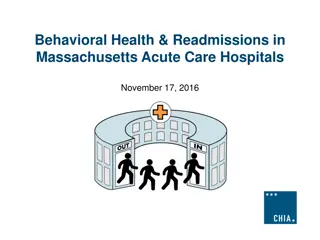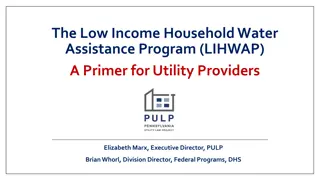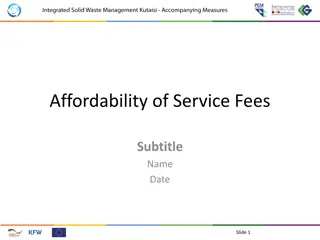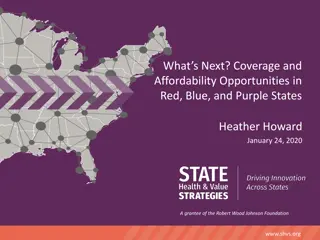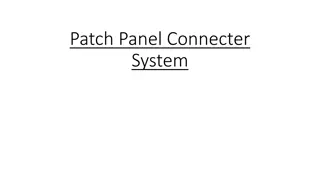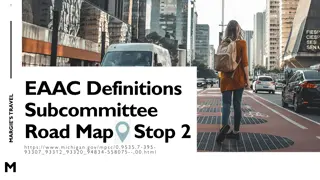Promoting Affordability Strategies in Massachusetts Health Connector
The Massachusetts Health Connector serves as the state's health insurance marketplace, providing residents with access to affordable health coverage options. Through initiatives like ConnectorCare and state-funded subsidies, Massachusetts has successfully increased coverage rates and maintained low premium costs, positioning itself as a national leader in healthcare access and affordability.
Uploaded on Oct 02, 2024 | 2 Views
Download Presentation

Please find below an Image/Link to download the presentation.
The content on the website is provided AS IS for your information and personal use only. It may not be sold, licensed, or shared on other websites without obtaining consent from the author.If you encounter any issues during the download, it is possible that the publisher has removed the file from their server.
You are allowed to download the files provided on this website for personal or commercial use, subject to the condition that they are used lawfully. All files are the property of their respective owners.
The content on the website is provided AS IS for your information and personal use only. It may not be sold, licensed, or shared on other websites without obtaining consent from the author.
E N D
Presentation Transcript
Promoting Affordability Perspectives from Massachusetts AUDREY MORSE GASTEIER Chief of Policy and Strategy Massachusetts Health Connector Families USA, Health Action 2019 | January 25, 2019
Health Connector Overview The Health Connector is the state s health insurance marketplace, offering Massachusetts residents and small businesses a way to understand their health coverage options, access affordability help, and compare and enroll in quality health and dental plans. The Health Connector was created in 2006 as part of a set of state health reforms aimed at increasing access to health insurance in Massachusetts, and later adapted to incorporate the federal health reforms of the Affordable Care Act (ACA) In addition to its role as a place to find and compare coverage, the Health Connector plays an active policy role in Massachusetts version of health reform, such as determining the policies that govern the Commonwealth s requirement to have health insurance Two of the key ways that Massachusetts promotes affordability for residents are through: Our wrap program which uses state-financed subsidies on top of ACA subsidies Creates direct affordability for enrollees, but also indirectly incentives lower premiums for unsubsidized individuals and small groups, too Our state individual mandate 2 2
Health Connector Overview The Health Connector's programs, outreach and public education efforts, and policies have helped Massachusetts lead the nation in coverage rates. 97% 97% More than 97% of Massachusetts residents are insured Million Million More than a quarter million Massachusetts residents are served by the Health Connector $332 $332 The Health Connector has the second lowest silver benchmark plan in the country for three years running $385 $385 In 2018, the Health Connector had the lowest average individual premiums of any Exchange in the country, despite otherwise high health care costs 3 3
ConnectorCare: Our State Wrap Program
ConnectorCare: Our State Wrap Program ConnectorCare leverages ACA subsidies, and wraps them with additional state subsidies to offer low monthly premiums and point-of- service cost-sharing. 2019 ConnectorCare lowest-cost premiums by plan type Plan Types 1 & 2A 0-150% FPL Plan Type 2B 150%-200% FPL Plan Type 3A 200%-250% FPL Plan Type 3B 250%-300% FPL $0 $44 $85 $126 For residents <300% FPL eligible for advance premium tax credits. Enrollees are divided into 5 plan types based on income Enrollees make per-member premium contributions based on their plan types, in base amounts ranging from $0 to $126/monthly for 2019 Plans have modest co-pays, but no deductibles or coinsurance Makes coverage affordable and accessible for ~200K low and lower-middle income residents that may otherwise struggle to remain covered 5 5
ConnectorCare Back-End Design Each ConnectorCare plan is built from a foundation of ConnectorCare compatible Silver plans that meet Health Connector specifications. These commercial plans are then enriched according to program standards. Each selected carrier s lowest-cost Silver tier plan is used as the base for ConnectorCare plans and is enriched with premium and cost-sharing subsidies from the state, in addition to federal advance premium tax credits. The program incorporates multiple financial sources that must, in total, cover the full cost of coverage: Premium = Federal premium tax credits + state premium subsidy + enrollee contributions Cost Sharing = State cost-sharing reductions (CSRs) + enrollee copayments (prior to 2018, also federal CSRs) State premium and cost-sharing subsidies are funded through our Commonwealth Care Trust Fund (CCTF), which gets funding from state tobacco tax, contributions from employers, and penalty revenue via the state individual mandate 6 6
Role of State Individual Mandate in Promoting Affordability
Individual Mandate & Affordability Massachusetts s 12-year-old state-level individual mandate plays a unique role in promoting widespread coverage, but also in promoting affordability. Massachusetts established a state-level individual mandate as part of its 2006 health reform law. While individual mandates are widely understood to promote coverage and ensure risk pool stability, they have other less-discussed, but important benefits related to affordability: Creating ceilings on cost sharing Ability to stem market traction of less robust/ gray market plans that can leave consumers exposed Outreach capabilities enabled by mandate administration, which in turn helps affordability for those who can be newly enrolled + overall risk pool 8 8
Individual Mandate & Affordability The Health Connector plays a key policy role in multiple elements of the state mandate: Minimum Creditable Coverage Affordability Schedule The Health Connector defines the types of insurance plans that are sufficient for individuals to meet minimum creditable coverage (MCC) requirements Under state law, adult residents must have insurance coverage if it is considered affordable The Health Connector annually establishes a schedule of amounts that would be considered an affordable amount to pay for health insurance, based on an individual s income and household size MCC standards include requirements on what services are covered and what levels of cost sharing are permissible A Massachusetts resident who can afford insurance must have an insurance plan that meets MCC standards or else face a tax penalty under state law 9 9
Individual Mandate & Cost Sharing Minimum Creditable Coverage (MCC) allows the state to encourage an upper-bound on cost sharing for individuals complying with the state s mandate. In addition to requiring that MCC meets key benefits requirements (e.g., hospitalization, Rx, maternity care, etc.), coverage must also meet cost sharing requirements MCC regulations prohibit annual benefit limits on core services and set out parameters for out of pocket spending Compliant plans must cap deductibles at $2,000 for individual coverage and $4,000 for family coverage, with separate prescription drug deductibles capped at $250 for individual coverage and $500 for family coverage The maximum out of pocket amount for a compliant plan may not exceed the maximum defined by the U.S. Department of Health and Human Services each year. (In 2019, this is $7,900 for an individual, and $15,800 for a family.) These requirements effectively encourage our market (across market segments, payers, coverage types, etc.) to offer coverage with relatively modest cost sharing parameters 10 10
Individual Mandate & Cost Sharing As states contemplate similar measures that protect against excessive out of pocket spending, they may consider that MCC standards can: Help protect against medical debt and forgone care Can have premium impacts Make it difficult to design low AV/bronze plans 11 11
Looking Ahead in Massachusetts Massachusetts s goals in the coming years as it relates to affordability Preserving and strengthening our state wrap program Rebolstering awareness of our state-level individual mandate through our #staycovered campaign Intensifying efforts and focus on small business affordability Creative thinking for unsubsidized population exposed to full premiums Learning from other states and thought leaders around the nation 12 12
ConnectorCare Plan Availability Enrollees can choose from up to 4 carriers, but may pay more based on the plan they select. Enrollee Premium Contribution By Plan Type Enrollee Premium Contribution By Plan Type Enrollee Premium Contribution By Plan Type Region C2 Region C2 Region F1 Region F1 Region A1 Region A1 1 1 2A 2A 2B 2B 3A 3A 3B 3B 1 1 2A 2A 2B 2B 3A 3A 3B 3B 1 1 2A 2A 2B 2B 3A 3A 3B 3B <100%FPL 100-150% FPL 150-200% FPL 200-250% FPL 250-300% FPL 1 1 Tufts-Direct $0 $0 $44 $85 $126 Tufts-Direct $0 $0 $44 $85 $126 1 BMC $0 $0 $44 $85 $126 2 2 BMC $0 $0 $44 $85 $126 BMC $0 $0 $44 $85 $126 2 Tufts-Direct $0 $0 $44 $85 $126 AllWays Health Partners 3 Fallon $72 $74 $119 $160 $201 3 $211 $210 $257 $299 $344 3 HNE $122 $121 $168 $210 $254 AllWays Health Partners 4 $195 $190 $238 $278 $321 AllWays Health Partners 4 $159 $157 $205 $248 $293 Enrollee Premium Contribution By Plan Type Region F2 Region F2 1 1 2A 2A 2B 2B 3A 3A 3B 3B Enrollee Premium Contribution By Plan Type Region A2 Region A2 AllWays Health Partners 1 1 1 2A 2A 2B 2B 3A 3A 3B 3B $0 $0 $44 $85 $126 1 BMC $0 $0 $44 $85 $126 2 Tufts-Direct $0 $0 $44 $85 $126 Enrollee Premium Contribution By Plan Type Region G1 Region G1 3 HNE $122 $121 $168 $210 $254 1 1 2A 2A 2B 2B 3A 3A 3B 3B 1 Tufts-Direct $0 $0 $44 $85 $126 2 BMC $0 $0 $44 $85 $126 Enrollee Premium Contribution By Plan Type Region A3 Region A3 1 1 2A 2A 2B 2B 3A 3A 3B 3B 1 Tufts-Direct $0 $0 $44 $85 $126 2 HNE $72 $116 $165 $208 $251 Enrollee Premium Contribution By Plan Type Region A4 Region A4 1 1 2A 2A 2B 2B 3A 3A 3B 3B 1 HNE $0 $0 $44 $85 $126 Enrollee Premium Contribution By Plan Type Region B1 Region B1 Enrollee Premium Contribution By Plan Type 1 1 2A 2A 2B 2B 3A 3A 3B 3B Region D1 Region D1 1 1 2A 2A 2B 2B 3A 3A 3B 3B 1 Fallon $0 $0 $44 $85 $126 Enrollee Premium Contribution By Plan Type 2 1 Tufts Direct $0 $0 $44 $85 $126 Tufts-Direct $0 $0 $44 $85 $126 Region G2 Region G2 1 1 2A 2A 2B 2B 3A 3A 3B 3B 3 2 BMC $0 $0 $44 $85 $126 BMC $0 $0 $44 $85 $126 AllWays Health Partners AllWays Health Partners AllWays Health Partners 1 4 3 $0 $0 $44 $85 $126 $156 $157 $205 $246 $291 $168 $168 $215 $256 $300 Enrollee Premium Contribution By Plan Type Enrollee Premium Contribution By Plan Type Enrollee Premium Contribution By Plan Type Region C1 Region C1 Region E1 Region E1 Region G3 Region G3 1 1 2A 2A 2B 2B 3A 3A 3B 3B 1 1 2A 2A 2B 2B 3A 3A 3B 3B 1 1 2A 2A 2B 2B 3A 3A 3B 3B 1 1 1 Tufts-Direct $0 $0 $44 $85 $126 Tufts-Direct $0 $0 $44 $85 $126 Tufts-Direct $0 $0 $44 $85 $126 2 2 2 BMC $0 $0 $44 $85 $126 BMC $0 $0 $44 $85 $126 BMC $0 $0 $44 $85 $126 AllWays Health Partners AllWays Health Partners AllWays Health Partners 3 3 3 $195 $190 $238 $278 $321 $224 $221 $267 $308 $349 $235 $276 $323 $366 $413 14
ConnectorCare Financing: 2018-2019 Premium Makeup Cost-Sharing Makeup (AV) Total Premium: $326 $0 $0 $1 $13 $44 99.6% State CSR (-06) $85 ~95% State CSR (-05) $37 $126 ~95% State CSR (-05) $71 ~92% State CSR (-04) 94% Federal CSR (-06) 94% Federal CSR (-06) ~92% State CSR (-04) $324 $313 87% Federal CSR (-05) $114 $245 73% Federal CSR (-04) $170 70% Base Silver (-01) 70% Base Silver (-01) 70% Base Silver (-01) 70% Base Silver (-01) 70% Base Silver (-01) $86 Plan Type 1 <=100% FPL Plan Type 2A 100%-150% FPL Plan Type 2B 150%-200% FPL Plan Type 3A 200%-250% FPL Plan Type 3B 250%-300% FPL Plan Type 1 <=100% FPL Plan Type 2A 100%-150% FPL Plan Type 2B 150%-200% FPL Plan Type 3A 200%-250% FPL Plan Type 3B 250%-300% FPL Federal Subsidy State Subsidy Enrollee Contribution Notes: Illustrative rates for a 42-year old in Boston in 2019, with FPL of 75%, 125%, 175%, 225% and 275% Applies maximum APTC and selects lowest-cost plan
